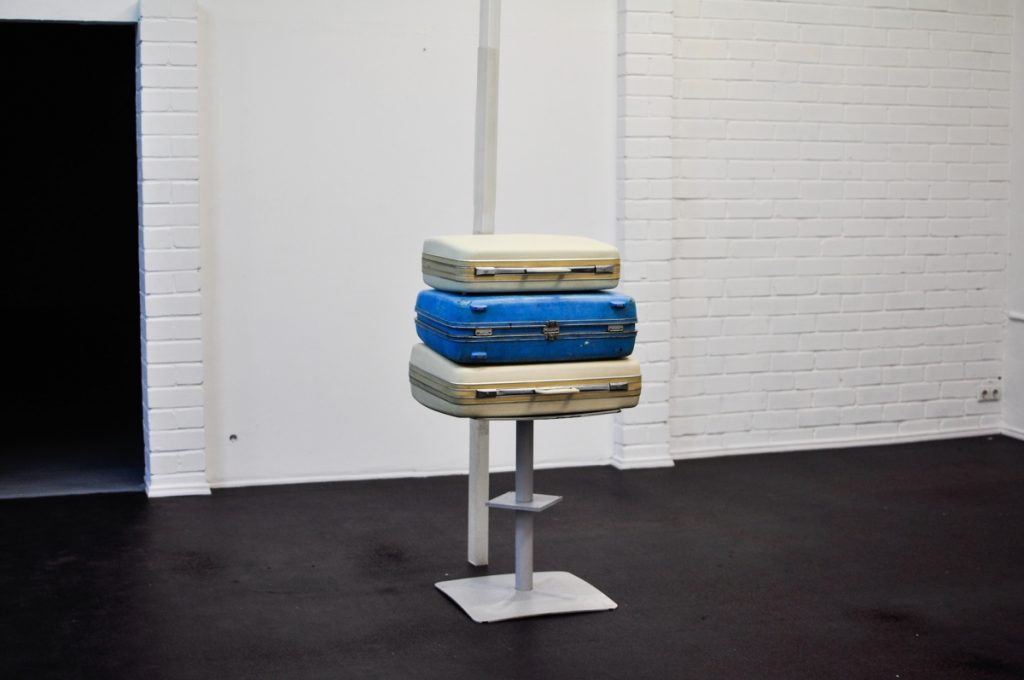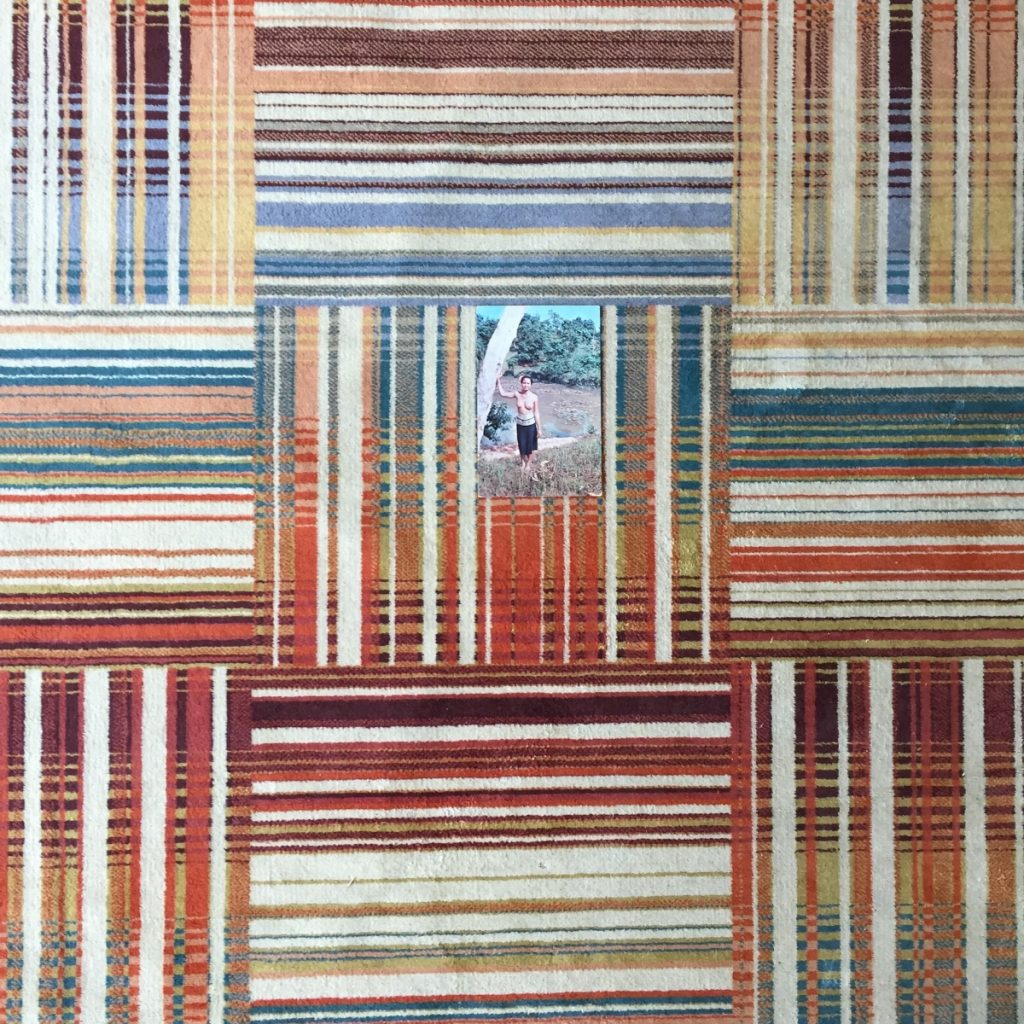 I’m driving a white Dodge Challenger through a desert. If I was from the Wild West, I’d say it’s the norm, but I’m a Lithuanian woman. This fairly stereotypical impression of Western culture from across the Atlantic only returned to me after learning more about the title of the recent exhibition Vanishing Point by the artist Dainius Liškevičius, which opened at the Kaunas POST gallery on the 21st of October 2016. One of the strong characteristics in Liškevičius’ creative work is his critical expression of criticism towards the world (to make a broad generalisation). He is a contemporary artist who brings things to exhibitions, leaving enough space around these, giving the visitor room to think. In this exhibition, Liškevičius placed a collection of found and created objects into the POST gallery.
I’m driving a white Dodge Challenger through a desert. If I was from the Wild West, I’d say it’s the norm, but I’m a Lithuanian woman. This fairly stereotypical impression of Western culture from across the Atlantic only returned to me after learning more about the title of the recent exhibition Vanishing Point by the artist Dainius Liškevičius, which opened at the Kaunas POST gallery on the 21st of October 2016. One of the strong characteristics in Liškevičius’ creative work is his critical expression of criticism towards the world (to make a broad generalisation). He is a contemporary artist who brings things to exhibitions, leaving enough space around these, giving the visitor room to think. In this exhibition, Liškevičius placed a collection of found and created objects into the POST gallery.
The text accompanying the exhibition provided several ‘keys’, so let’s see if we can use them to understand Liškevičius’ intentions. The press release states that “The Vanishing Point exhibition consists of a personal collection of ready-mades and objects. Through the stories of their discoveries in specific places, the objects begin to form relationships with each other and create a new narrative”. As such, the exhibition has been separated into seven parts, the first of which is the name itself, which was drawn from the American film Vanishing Point (1971). However, we will return to the exhibition’s first part later.
Based on real events (There once lived two brothers, but then one killed the other) – this is Dainius Liškevičius’ name for the second part. It instinctively hints at the story of Adam and Eve – a tale as old as time – and to their children, Cain and Abel, in which Cain kills his brother Abel out of envy. Liškevičius’ collection of objects, formed in the gallery’s first hall, implies that the author is referring to this story from the Old Testament in which Cain, an unrepentant sinner, was damned to wander the world without ever finding peace. Looking at the objects on display and their assemblage in the gallery’s first hall (a hamster cage, sticks, a structure made of coconuts, etc.), my thoughts were guided towards that of an altar linking to the story of these two brothers, and towards the firewood prepared for the wanderer. His wandering without peace is like being trapped in a cage.
Though the ‘keys’ were provided by the author, it was the beholder who decided which doors to unlock, a choice that was (unavoidably) influenced by personal context. And perhaps that’s the point of the exhibition, to find and select your own door, to open it and step through it peacefully. You won’t have to go far to see Putin being transformed into a mouse.
Of course, I’m not talking about Putinas, the author of the Altorių Šešėly (In the Shadows of Altar) novel widely read in Lithuania, but about another Putin that we see a lot of online on news sites, social network sites, newspapers, television and discuss over beer and wine. That is the same Putin I had to look at on the Friday night of the exhibition’s opening, which bring me to find the third part of the exhibition which the guide indicated as being called Rex. It came as no surprise that Liškevičius, who can’t avoid using a bit of irony, has made references to Vladimir Putin as a ‘king’ in his collection as an old CRT monitor displayed Latvia’s Eastern neighbour’s leader. The display was calm, to the point of lifelessness, appearing stuck- as though it was stuck on him. Our large neighbour’s leader was being displayed grotesquely: the television seemed to have been dropped and discarded with its corner leaning against the wall. The extended palms of the composition with the hero’s exposed teeth inspired other images of rodents. This image is reinforced by a power cable coiled behind the monitor like a rodent’s tail. One needn’t take much time to measure the key here, as it’s pretty self evident to see Liškevičius’ clear criticism for the Russian leader, physical and contextual humiliation, designed to remove Putin’s crown.
The fourth part of Vanishing Point – The Kidnapping of Europa has the greatest number of items on display of which I cannot mention all. Of course, after Putin’s portrait, the phrase “the kidnapping of Europa”, not only becomes a nod to Greek mythology, but a systematic transition on the artist’s part from ancient sins described in the Bible (Cain’s story) to the globally shocking madness of modern politics and warfare. Yes, one door often leads to another.
According to older customs in Christian houses of worship, men stood to the right and women stood to the left. Though these traditions are probably rarely followed these days, a certain aspect of Liškevičius’ exhibition reminded me of this custom with the space feeling as if it had been separated into masculine and feminine sides. In truth, I don’t think I would have noticed this myself, had it not have been pointed out to me by someone else. However, when reviewing Liškevičius’ collection in this part of the exhibition, the intention became quite convincing that it became hard to neglect, especially seeing how the church’s etiquette was expressed: the right side of the hall was filled with unusual and, undeniably, surprising ensembles or groups of objects. One included the figure of baby Jesus on a toy pool table with a man standing before it (a cliché of masculine activities). If this man standing before the table (wearing a suit) was not a God of the modern era then, at the very least, he seemed like an icon of power.
Meanwhile, to the left-hand side of the hall, the artist had continued to operate using Christian religious images by expressing the unrest caused by problematic relationships and unions or differences. For example, a folder on display in a glass case was filled with adult publications, one of which was opened to a page which the exhibition guide explained was a men’s magazine called REX (yet another ‘king’ which the author intended me to find, perhaps, before the door led me to Putin! It seems that I, like Cain, will wander until the end). Because the publication was for men, one could easily predict its content to feature naked women. Another image of a woman is also presented in the exhibition, though she is apparently caged. According to the exhibition’s synopsis, this is a “well-known company’s advertising poster with a woman’s face, the good side of which was covered in boards, found in Kassel during the Documenta ’13 exhibition.” Another object that was also on display in this part of the exhibition was the statue of the Virgin Mary, which presented an unsettling and difficult atmosphere given the context of its worldly surroundings. These varying images of women were full of contrast, signifying their different positions and ambiguous roles throughout history.
The fifth part of the exhibition was called Athens. According to the exhibition’s guide, it was a “35 mm video reel with images from inside a human body taken using an x-ray. 1.20 min., found in 2015 in Athens”. The colourless flashing images in the final darkened hall of the gallery inspired a more romantic mood indeed! This was helped by the exhibition’s sixth element, the periodic ‘soundtrack’ featuring the 1959 song WO IST DAS LAND (Where is the Land?) by Melitta Berg. In today’s context, the song sounds exotic or celebratory and convincing, even when you can barely understand what the song is about.
The seventh and final part of the exhibition – Subtitles (Time Machine 0:00) – invites me, once again, to reference the first part of the exhibition from the exhibition synopsis dedicated to its name. It describes the exhibition’s situation as follows: “Upon starting to connect objects in a certain order, the artist understood that something had been hidden from him all along. Upon waking up to the ongoing ending of the film Vanishing Point, he remembers that he has to retrieve a gold ring he ordered from a jeweller. As he continued his work, the hero tried to quickly understand the whole and understand who’s sending him the message, though, to the very end, it’s not even clear who the messenger is. Perhaps it’s himself? Confused and overcome by a sense of déjà vu, he walks about during the opening of his exhibition with the feeling that he’s seen all of this somewhere before…” The artist himself has already drawn the observer’s attention to the axis of time, which for me is related to another important element that I have been waiting to approach: the number seven.
As we well remember, the exhibition was separated into seven parts. The meaning of the word Sheba (seven), derived from the Hebrew language, is ‘completion’. This number symbolises this concept in a number of religions. Because Liškevičius consistently maintains links to religion, once again it seems like it would be important to connect the importance of the seventh number to Christianity: God created the world in seven days and there are seven sacraments and seven cardinal sins. Finally, I once read that the cells in a person’s body transfer information to other cells before dying every seven seconds. The exhibition reflects this history and, perhaps, suggests the idea of a new beginning, or the end of something else.
After visiting all of the parts of the exhibition, I want to return to the first one – its name, which was ‘borrowed’ (as the author calls it) from an American film full of car chases (Vanishing Point, 1971, dir. Richard C. Sarafian). What’s beautiful is that, from the very beginning, the artist maintains his style of incorporating readymade objects. One thing that’s even more intriguing and might bring a smile to your face is that the author has created an impressionist essay called the Exhibition Synopsis for this first – physically non-existent – part of the exhibition that I have used to delve into Liškevičius’ diverse collection of objects.
The combination of the words ‘Vanishing Point’ is an exhibition and a readymade of its own. The plot of this American film featured Western US landscapes which the main character had to drive a white Dodge Challenger from Denver to San Francisco. Yes, a white Challenger, much like the one I drove, though this one from 1970 is of a slightly more vintage year! This sports car which, to this day, has become an icon, brought me through a grand doorway of memories where I recalled the story of myself and of Europe.
Dainius Liškevičius thinks in objects. He is an artist who speaks using objects, their relationships, their forms and their positions. While moving through the collection of objects being presented, the visitor could clearly select the clues they understood best to begin constructing the ‘author’s idea’. The exhibition’s contrasting name – Vanishing Point – created a sort of inertia for a converging phenomenon where the story being told by the author became interwoven with that of my own, and of other individual beholders, as their lines (both in terms of time and stories) became blurred as well.

























Photography: Courtesy of organizers and the artist






























